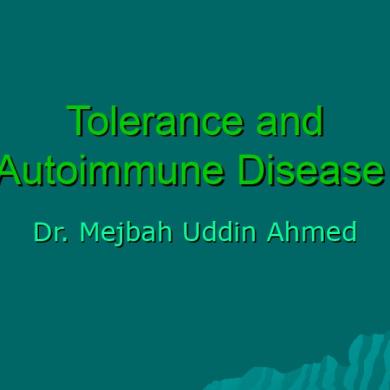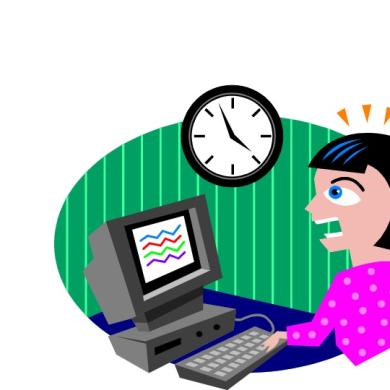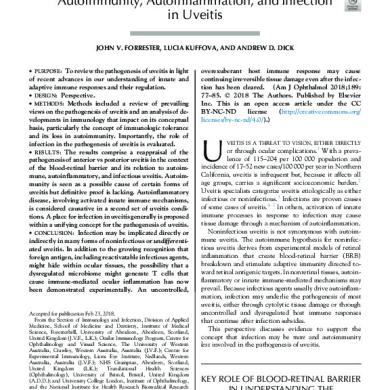2. Autoimmunity
This document was uploaded by user and they confirmed that they have the permission to share it. If you are author or own the copyright of this book, please report to us by using this DMCA report form. Report DMCA
Overview
Download & View 2. Autoimmunity as PDF for free.
More details
- Words: 1,215
- Pages: 34
2. Autoimmunity or Autoantibodies Inappropriate reaction by the immune system in which antibodies form against self antigens, mistaken as foreign. E.g. – Tissue injury ( may help the body rid itself of damaged or necrotic self component)
Etiology: – Altered antigens – Cross reactive antibodies – Viral factors – Hormonal factors – Genetic factors
Pathophysiology: 3 ways of auto immune response cause disease The action of antibodies on cell surfaces: by direct antibody-mediated cellular cytotoxicity--interference with receptors --- or complement activation. The circulation and deposition of small immune complexes : soluble antigen-antibody complexes – invade and deposit in the capillaries, the synovium of joints--- it causes tissue damage via activation of the complement system. Activation of sensitized T lymphocytes: by the release of lymphokines.
– Intervention: Anti-inflammatory agents – symptomatic relief.
Assessment and Management of Patients With Allergic Disorders
Allergic Reactions Allergy – An inappropriate, often harmful response of the immune system to normally harmless substances – Hypersensitive reaction to an allergen initiated by immunological mechanisms that is usually mediated by IgE antibodies Allergen: the substance that causes the allergic response Atopy: allergic reactions characterized by IgE antibody action and a genetic predisposition
Immunoglobulins and Allergic Response Antibodies (IgE, IgD, IgG, IgM, and IgA) react with specific effector cells and molecules, and function to protect the body IgE antibodies are involved in allergic disorders IgE molecules bind to an allergen and trigger mast cells or basophils These cells then release chemical mediators such as histamine, serotonin, kinins, SRS-A, and neutrophil factor These chemical substances cause the reactions seen in allergic response
Immunoglobulins and Allergic Response (cont.) Allergen triggers the B cell to make IgE antibody, which attaches to the mast cell; when that allergen reappears, it binds to the IgE and triggers the mast cell to release its chemicals
Hypersensitivity A reflection of excessive or aberrant immune response Sensitization: initiates the buildup of antibodies
Predisposing Factors Host defenses Nature of the allergen Concentration of the allergen Route of allergen entrance into the body Exposure to the allergen
Types of hypersensitivity reactions – Anaphylactic: type I – Cytotoxic: type II – Immune complex: type III – Delayed type: type IV
Type I—Anaphylactic Reaction
– Type I.Anaphylactic shock Most severe form of type I hypersensitivity Clinical Manifestations: – Itching – Edema – Sneezing ( wheezing, dyspnea, cyanosis, circulatory shock) – ASAP emergency treatment
Prevention: – History: drugs ( antibiotics- penicilllins); Foods ( seafoods); Insect venoms; Biologicals ( vaccines, hormones, enzymes, antisera); blood products; allergen extracts; diagnostic agents ( dye)
Type II—Cytotoxic Reaction
– Type II Cytolytic or Cytotoxic Hypersensitivity The antigen-antibody complex and complement attach to a cell – circulating blood cell cell lysis. Blood transfusion - blood incompatibility cell lysis ( transfusion reaction – of donor RBC) Note: Blood transfusion > 100ml. incompatible – renal damage, circulatory shock, and death.STOP Transfusion ASAP. Clinical Manifestations: – – – – –
Headache and backpain Chest pain- similar to angina N& V Tachycardia and hypotension Hematuria
Type III—Immune Complex Reaction
Type III Immune Complex Hypersensitivity
– From the formation or deposition of antigen-antibody complexes in tissues – Molecular size – larger – rapidly cleared by phagocytic cells.--- smaller persists longer in circulation spleen and liver Inflammation - acute or chronic disease of the organ system
E.g. serum sickness, urticaria, arthritis, arteritis, glomerulonephritis.
Type IV—Delayed or Cellular Reaction
Type IV Cell Mediated Delayed Hypersensitivity – Sensitized T cells respond to antigens by releasing lymphokines, which direct phagocytic cell activity. – E.g. Delayed hypersensitivity – chronic infection ( TB)
Graft versus host disease or transplant rejection
- Contact Dermatitis (48-72) - Granuloma formation- 10-28 days, (leprosy)
Management of Patients With Allergic Disorders History and manifestations; comprehensive allergy history; Diagnostic tests – CBC-eosinophil count – Total serum IgE – Skin tests: note precautions Screening procedures
Medication Oxygen, if respiratory assistance needed Epinephrine for anaphylactic reactions AntiHistamines Corticosteroids
Prevention and Treatment of Anaphylaxis Screen and prevent: Treat respiratory problems; provide oxygen, intubation, and cardiopulmonary resuscitation as needed Epinephrine: 1:1,000 SQ Auto injection system: EpiPen May follow with IV epinephrine IV fluids
Other Allergic Disorders Contact dermatitis Atopic dermatitis Drug reactions (dermatitis medicamentosa) Urticaria and angioneurotic edema Food allergy Serum sickness Latex allergy
The round or disk shaped (discoid) rash of lupus produces red, raised patches with scales. The pores (hair follicles) may be plugged. Scarring often occurs in older lesions. The majority (approximately 90%) of individuals with discoid lupus have only skin involvement as compared to more generalized involvement in systemic lupus erythematosis (SLE).
Systemic Lupus Erythematous (SLE) a chronic inflammatory disease of autoimmune origin. presence of autoantibodies to numerous nuclear proteins, blood and nerve cells, and blood proteins. Inflammation – every organ system. Lesions: connective tissue of the vascular system, the kidney, the dermis, the serous, synovial membranes. Long and chronic, with exacerbations, remissions.
Etiology and Incidence SLE is associated with a genetic predisposition to the disease as well as a family history autoimmune disorders. It occurs most commonly in women, especially among those ages 20-30; incidence is higher among African Americans than whites
PATHOPHYSIOLOGY (process & manifestation)
SLE is characterized by the formation of antibodies (IgE and IgM) against the body’s nucleic acids, phospholipids, white blood cells, red blood cells, and coagulation components. Antigen-antibody complexes against host DNA form and deposit in a variety of tissues, causing diffuse damage. Neutrophils attempt to phagocytize the antigen-antibody complexes, but are ineffective.
Lysosomal enzymes are released, further propagating the tissue damage. The glomerular basement membrane of the kidneys is particularly susceptible to complex deposition; as a result, there is a high incidence of renal failure secondary to SLE. Deposition of complex also occurs in the brain, heart lung, GI tract ,spleen and skin.
Clinical Manifestations: – Joint inflammation ( arthritis) – Classic butterfly rash over the cheeks and bridge of the nose. – Photosensitivity – renal, cardiac, and CNS dysfunction. (Raynaud’s Syndrome) – GI symptoms: n&v, esophagitis, anorexia
Other symptoms: Wt. loss; fever, malaise; lethargy
Laboratory Findings: – Presence of LE cells ( autoantibodies) – Decreased complement levels – Presence of immune complexes in serum – Presence of antibodies to DNA and antinuclear antibodies. – Decreased levels of rbc, wbc, plateletsIncreased gamma globulin fraction d/t increased antibody production.
Nursing Diagnoses: – Impaires physicl mobility d/t arthritis, malaise and lethargy. – Alt. in comfort: pain d/t inflammation – Fluid volume deficit d/t vomiting – Alt. in nutrition: less than body requirements d/t anorexia, nausea, esophagitis. – Potential for infection d/t poor physical condition – Grieving d.t chronic nature of SLE and advent exacerbations – Disturbance in self concept: body image d/t butterfly rash and alopecia – Alt. in tissue perfusion: renal, GI and peripheral d/t vasculitis.
Pharmacologic and Medical Intervention: – NSAID anti inflammatory agents e.g. Salicylates ( Aspirin) – Anti malarial drugs – cutaneous and joint inflammation. – Corticosteroids – d/t systemic inflammatory manifestations of the disease. – Cytotoxic agents : alkylating agents ( cyclosphamide), and antifolates ( methotrexate) – Plasmapheresis – remove circulating autoantibodies and immune complexes from the blood before organ and tissue damage occurs.
Other Interventions Improve airway clearance – Use semi-Fowler's or high-Fowler’s position – Pulmonary therapy; coughing and deep breathing; postural drainage; percussion; and vibration – Ensure adequate rest Pain – Administer medications as prescribed – Provide skin and perianal care
Etiology: – Altered antigens – Cross reactive antibodies – Viral factors – Hormonal factors – Genetic factors
Pathophysiology: 3 ways of auto immune response cause disease The action of antibodies on cell surfaces: by direct antibody-mediated cellular cytotoxicity--interference with receptors --- or complement activation. The circulation and deposition of small immune complexes : soluble antigen-antibody complexes – invade and deposit in the capillaries, the synovium of joints--- it causes tissue damage via activation of the complement system. Activation of sensitized T lymphocytes: by the release of lymphokines.
– Intervention: Anti-inflammatory agents – symptomatic relief.
Assessment and Management of Patients With Allergic Disorders
Allergic Reactions Allergy – An inappropriate, often harmful response of the immune system to normally harmless substances – Hypersensitive reaction to an allergen initiated by immunological mechanisms that is usually mediated by IgE antibodies Allergen: the substance that causes the allergic response Atopy: allergic reactions characterized by IgE antibody action and a genetic predisposition
Immunoglobulins and Allergic Response Antibodies (IgE, IgD, IgG, IgM, and IgA) react with specific effector cells and molecules, and function to protect the body IgE antibodies are involved in allergic disorders IgE molecules bind to an allergen and trigger mast cells or basophils These cells then release chemical mediators such as histamine, serotonin, kinins, SRS-A, and neutrophil factor These chemical substances cause the reactions seen in allergic response
Immunoglobulins and Allergic Response (cont.) Allergen triggers the B cell to make IgE antibody, which attaches to the mast cell; when that allergen reappears, it binds to the IgE and triggers the mast cell to release its chemicals
Hypersensitivity A reflection of excessive or aberrant immune response Sensitization: initiates the buildup of antibodies
Predisposing Factors Host defenses Nature of the allergen Concentration of the allergen Route of allergen entrance into the body Exposure to the allergen
Types of hypersensitivity reactions – Anaphylactic: type I – Cytotoxic: type II – Immune complex: type III – Delayed type: type IV
Type I—Anaphylactic Reaction
– Type I.Anaphylactic shock Most severe form of type I hypersensitivity Clinical Manifestations: – Itching – Edema – Sneezing ( wheezing, dyspnea, cyanosis, circulatory shock) – ASAP emergency treatment
Prevention: – History: drugs ( antibiotics- penicilllins); Foods ( seafoods); Insect venoms; Biologicals ( vaccines, hormones, enzymes, antisera); blood products; allergen extracts; diagnostic agents ( dye)
Type II—Cytotoxic Reaction
– Type II Cytolytic or Cytotoxic Hypersensitivity The antigen-antibody complex and complement attach to a cell – circulating blood cell cell lysis. Blood transfusion - blood incompatibility cell lysis ( transfusion reaction – of donor RBC) Note: Blood transfusion > 100ml. incompatible – renal damage, circulatory shock, and death.STOP Transfusion ASAP. Clinical Manifestations: – – – – –
Headache and backpain Chest pain- similar to angina N& V Tachycardia and hypotension Hematuria
Type III—Immune Complex Reaction
Type III Immune Complex Hypersensitivity
– From the formation or deposition of antigen-antibody complexes in tissues – Molecular size – larger – rapidly cleared by phagocytic cells.--- smaller persists longer in circulation spleen and liver Inflammation - acute or chronic disease of the organ system
E.g. serum sickness, urticaria, arthritis, arteritis, glomerulonephritis.
Type IV—Delayed or Cellular Reaction
Type IV Cell Mediated Delayed Hypersensitivity – Sensitized T cells respond to antigens by releasing lymphokines, which direct phagocytic cell activity. – E.g. Delayed hypersensitivity – chronic infection ( TB)
Graft versus host disease or transplant rejection
- Contact Dermatitis (48-72) - Granuloma formation- 10-28 days, (leprosy)
Management of Patients With Allergic Disorders History and manifestations; comprehensive allergy history; Diagnostic tests – CBC-eosinophil count – Total serum IgE – Skin tests: note precautions Screening procedures
Medication Oxygen, if respiratory assistance needed Epinephrine for anaphylactic reactions AntiHistamines Corticosteroids
Prevention and Treatment of Anaphylaxis Screen and prevent: Treat respiratory problems; provide oxygen, intubation, and cardiopulmonary resuscitation as needed Epinephrine: 1:1,000 SQ Auto injection system: EpiPen May follow with IV epinephrine IV fluids
Other Allergic Disorders Contact dermatitis Atopic dermatitis Drug reactions (dermatitis medicamentosa) Urticaria and angioneurotic edema Food allergy Serum sickness Latex allergy
The round or disk shaped (discoid) rash of lupus produces red, raised patches with scales. The pores (hair follicles) may be plugged. Scarring often occurs in older lesions. The majority (approximately 90%) of individuals with discoid lupus have only skin involvement as compared to more generalized involvement in systemic lupus erythematosis (SLE).
Systemic Lupus Erythematous (SLE) a chronic inflammatory disease of autoimmune origin. presence of autoantibodies to numerous nuclear proteins, blood and nerve cells, and blood proteins. Inflammation – every organ system. Lesions: connective tissue of the vascular system, the kidney, the dermis, the serous, synovial membranes. Long and chronic, with exacerbations, remissions.
Etiology and Incidence SLE is associated with a genetic predisposition to the disease as well as a family history autoimmune disorders. It occurs most commonly in women, especially among those ages 20-30; incidence is higher among African Americans than whites
PATHOPHYSIOLOGY (process & manifestation)
SLE is characterized by the formation of antibodies (IgE and IgM) against the body’s nucleic acids, phospholipids, white blood cells, red blood cells, and coagulation components. Antigen-antibody complexes against host DNA form and deposit in a variety of tissues, causing diffuse damage. Neutrophils attempt to phagocytize the antigen-antibody complexes, but are ineffective.
Lysosomal enzymes are released, further propagating the tissue damage. The glomerular basement membrane of the kidneys is particularly susceptible to complex deposition; as a result, there is a high incidence of renal failure secondary to SLE. Deposition of complex also occurs in the brain, heart lung, GI tract ,spleen and skin.
Clinical Manifestations: – Joint inflammation ( arthritis) – Classic butterfly rash over the cheeks and bridge of the nose. – Photosensitivity – renal, cardiac, and CNS dysfunction. (Raynaud’s Syndrome) – GI symptoms: n&v, esophagitis, anorexia
Other symptoms: Wt. loss; fever, malaise; lethargy
Laboratory Findings: – Presence of LE cells ( autoantibodies) – Decreased complement levels – Presence of immune complexes in serum – Presence of antibodies to DNA and antinuclear antibodies. – Decreased levels of rbc, wbc, plateletsIncreased gamma globulin fraction d/t increased antibody production.
Nursing Diagnoses: – Impaires physicl mobility d/t arthritis, malaise and lethargy. – Alt. in comfort: pain d/t inflammation – Fluid volume deficit d/t vomiting – Alt. in nutrition: less than body requirements d/t anorexia, nausea, esophagitis. – Potential for infection d/t poor physical condition – Grieving d.t chronic nature of SLE and advent exacerbations – Disturbance in self concept: body image d/t butterfly rash and alopecia – Alt. in tissue perfusion: renal, GI and peripheral d/t vasculitis.
Pharmacologic and Medical Intervention: – NSAID anti inflammatory agents e.g. Salicylates ( Aspirin) – Anti malarial drugs – cutaneous and joint inflammation. – Corticosteroids – d/t systemic inflammatory manifestations of the disease. – Cytotoxic agents : alkylating agents ( cyclosphamide), and antifolates ( methotrexate) – Plasmapheresis – remove circulating autoantibodies and immune complexes from the blood before organ and tissue damage occurs.
Other Interventions Improve airway clearance – Use semi-Fowler's or high-Fowler’s position – Pulmonary therapy; coughing and deep breathing; postural drainage; percussion; and vibration – Ensure adequate rest Pain – Administer medications as prescribed – Provide skin and perianal care
Related Documents

2. Autoimmunity
May 2020 12
Autoimmunity
May 2020 8
Autoimmunity
December 2019 6
Immunodeficiency And Autoimmunity -bds
June 2020 7
Autoimmunity And Tolerance
July 2020 10More Documents from "Putri Dwi Kartini"

Stress
May 2020 5
2. Autoimmunity
May 2020 12
Stress Management
May 2020 5
